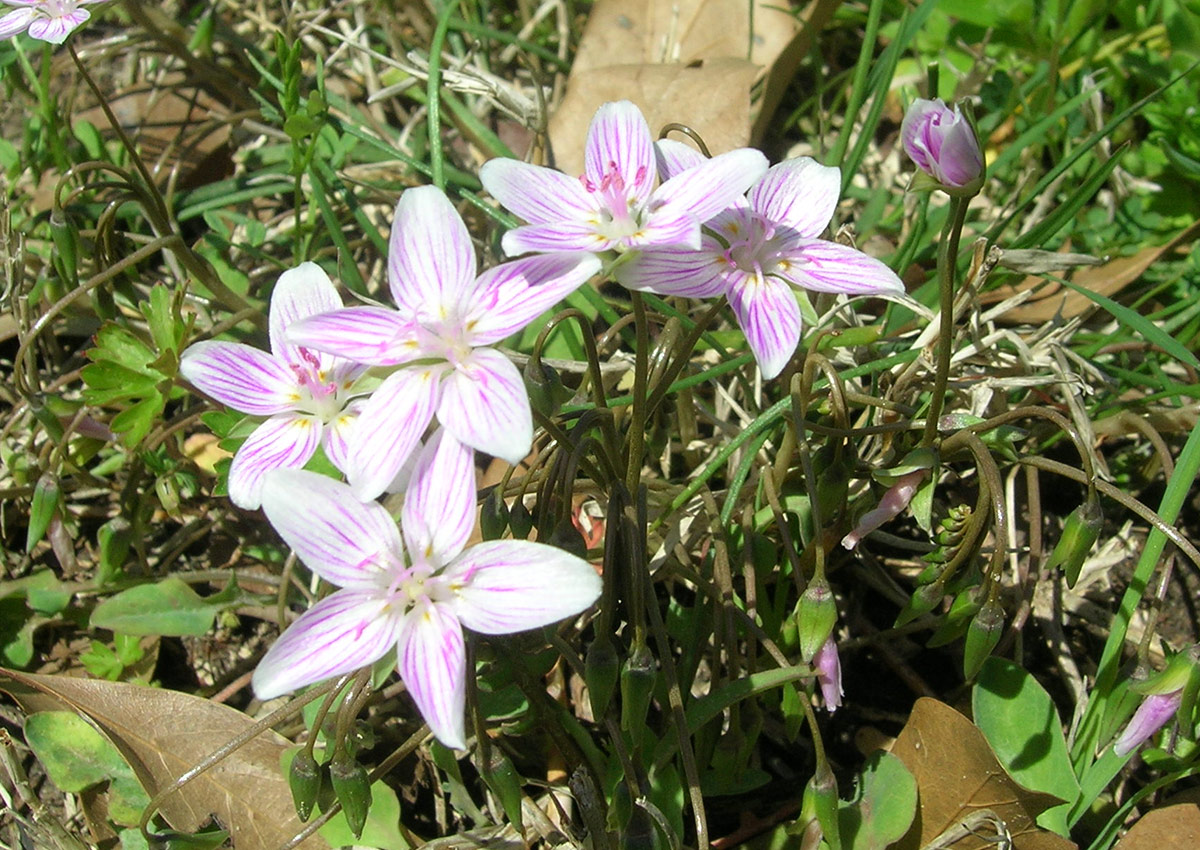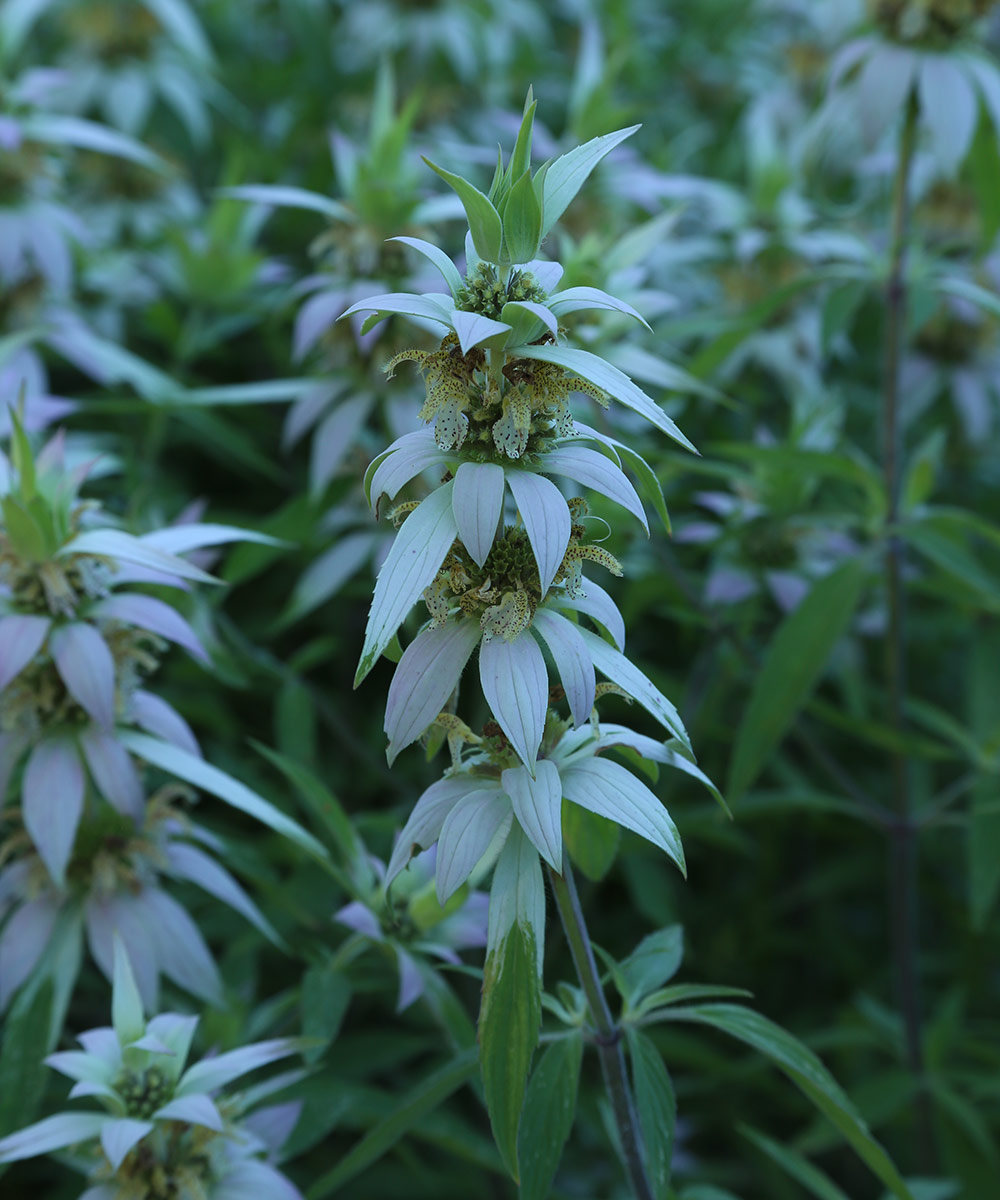
Honeybees and butterflies may be the poster children for pollinator awareness, but these charismatic garden visitors actually make up a very small portion of the species that move pollen from plant to plant. Commonly overlooked creatures like wasps, flies, moths, beetles, birds, bats, and even lizards can all serve as plant pollinators. Another misconception is that most pollinator activity occurs from the height of summer and into early fall, but in fact pollination occurs during most months of the year when temperatures are within an acceptable range for insect activity and there is a pollen or nectar source available. In this article I will talk about an array of plants that feed and support pollinators at specific points throughout the growing season. As you plan your wildlife-friendly plantings, use these suggestions as a springboard for creating your own unique, multiseason plant combinations.

Spring beauty is an essential pollen source for early-emerging solitary bees
Claytonia virginica
Zones: 3–8
Size: 6 to 9 inches tall and wide
Conditions: Full sun to partial shade; moderately moist, well-drained soil
Native range: Eastern North America
In undisturbed, moist woodlands in much of the eastern United States, coming across a mass of spring beauty in full bloom is a breathtaking experience. This diminutive spring ephemeral isn’t commonly grown in garden settings, but with its aesthetic beauty and ecological benefits it certainly deserves more attention. Many of our ground-dwelling native-bee species spend most of their lives underground. Often their emergence from the soil coincides with that of a specific plant species that provides an essential nutrient that allows for their life cycle to continue. Spring-beauty mining bees (Andrena erigeniae) rely heavily on spring beauty’s distinctive pink pollen to rear their young. The small tubers send forth grasslike foliage immediately after late-winter snow melts. Flowers soon follow, and all parts go dormant and return to the ground within a matter of weeks. A favorite food source of native Americans, the sweet, chestnut-flavored tuber was commonly traded for other goods and services, which could explain this plant’s wide distribution range.

‘Jeana’ garden phox is a beautiful selection that blooms from July through early September
Phlox paniculata ’Jeana’
Zones: 4–8
Size: 2 to 4 feet tall and 1½ to 3 feet wide
Conditions: Full sun to partial shade; average to rich, moist, well-drained soil
Native range: Eastern United States
Researchers at Mt. Cuba Center in Hockessin, Delaware, noted in a study that butterflies appear to greatly prefer ‘Jeana’ over other cultivars of tall garden phlox. Although the study did not determine the reason for this preference, ‘Jeana’ produces a large number of flowers per stalk and may provide more bang for a butterfly’s buck in a single visit. The blooms also have a delicate, sweet fragrance. Many garden phlox are prone to powdery mildew, but I have grown several specimens of this stellar cultivar and have never witnessed the disease. It can become quite tall in rich, moist soil, but cutting or pinching it back by half in late May will help to control the height.

‘Bluebird’ smooth blue aster produces protein-rich pollen well into fall
Symphyotrichum laeve ’Bluebird’
Zones: 4–8
Size: 3 to 4 feet tall and 2 to 3 feet wide
Conditions: Full sun, dry to average, well-drained soil
Native range: United States and Canada
Abundant blooms in an unusual violet-blue flower color were what set ‘Bluebird’ apart when it was discovered in Connecticut as a unique seedling. Those beautiful flowers along with glossy, bluish-green foliage and noteworthy resistance to pests and diseases qualify this adaptable perennial as one of the finest garden asters. It is a late fall bloomer that combines well with ornamental grasses and flowering perennials such as orange coneflower (Rudbeckia fulgida, Zones 3–9), Joe Pye weed (Eutrochium purpureum, Zones 4–9), and goldenrod (Solidago spp. and cvs., Zones 3–9), which also provide excellent late-season resources for native bees and migrating monarchs.

Spotted bee balm is drought tolerant and adaptable to many growing conditions
Monarda punctata
Zones: 3–8
Size: 18 to 24 inches tall and 9 to 12 inches wide
Conditions: Full sun to partial shade; dry to moderately moist, well-drained soil
Native range: Eastern North America
When gardening for pollinators, it is important to include host plants that provide food and habitat for pollinating insects during the larval stage of their life cycles. For example, butterflies and moths start out as caterpillars that feed on foliage and require a steady supply of their preferred plant species as they prepare to pupate. Spotted bee balm is the host plant for several lepidopterans, including gray marvel moth and snout moth. It has unusual, tiered flowers that attract and feed a number of butterfly and bee species and make excellent additions to floral bouquets as well. It has distinctive square stems that identify it as a member of the mint family, and all plant parts emit a pleasantly pungent herbal scent that deters rabbits and deer.

‘Husker Red’ penstemon attracts a diverse array of pollinators
Penstemon digitalis ‘Husker Red’
Zones: 3–8
Size: 2 to 3 feet tall and 1 to 2 feet wide
Conditions: Full sun; dry to average, well-drained soil
Native range: Eastern United States and southern Canada
Like the runway of any major airport, many flowers that produce nectar often have unique floral markings that light the way and guide insects to this nutritious supply. Husker Red penstemon is no exception.
‘Husker Red’ penstemon was the Perennial Plant Association’s Plant of the Year in 1996, and since then it has proven itself time and again to be a stellar garden plant for the Mid-Atlantic region. The abundant white to slightly pink flowers support a wide range of pollinators, including long-tongued bees, Halictid bees, moths, butterflies, and hummingbirds. It is also a larval host for several moth species. The attractive foliage emerges deep red to maroon in spring and retains a reddish cast that contrasts nicely with the floral display. The semi-evergreen leaves often remain attractive throughout the winter months, topped with glossy, almost-black seedpods. Flower production and foliage color are best when the plant is grown in full sun, but it also adapts quite well to dry spots in partial shade.
Adam Glas is a garden supervisor and rosarian at the Scott Arboretum of Swarthmore College in Swarthmore, Pennsylvania.
For more Mid-Atlantic regional reports, click here.
- To see a stylish garden design packed with appealing pollinator plants, check out this article: Designing a Stylish Pollinator Garden
- For more information about nativars and their value in home gardens, this article is a great resource: Are Nativars OK?
- For more plants that will attract butterflies to your garden: 4 Must-Have Butterfly Host Plants to Support Biodiversity
Fine Gardening Recommended Products

Alpine Corporation 28" Tall Outdoor Birdbath with Scrollwork Decoration Yard Statue
Fine Gardening receives a commission for items purchased through links on this site, including Amazon Associates and other affiliate advertising programs.

Buffalo-Style Gardens: Create a Quirky, One-of-a-Kind Private Garden with Eye-Catching Designs
Fine Gardening receives a commission for items purchased through links on this site, including Amazon Associates and other affiliate advertising programs.



















Comments
Log in or create an account to post a comment.
Sign up Log in